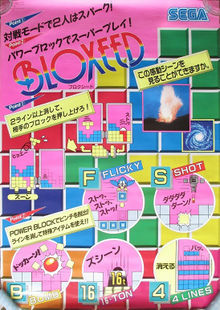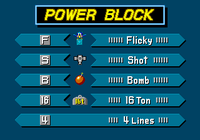Bloxeed
| Bloxeed | |
|---|---|
 Bloxeed arcade flyer | |
| Developer(s) | Sega |
| Publisher(s) | Sega |
| Platform(s) | Arcade |
| Release | 1989, 1990 |
| Gameplay info | |
| Next pieces | 1 |
| Playfield size | 10 × 20, ceiling in 21 |
| Hold piece | No |
| Hard drop | No |
| Rotation system | Sega rotation |
Bloxeed (ブロクシード) is a Tetris variant produced by Sega in 1990. It features similar gameplay to their 1988 version, where the aim is to achieve a high score by clearing lines; however there are now 2 major gameplay twists to make things more interesting, namely garbage and power blocks.
Gameplay
- Soft drop: 1G
- Lock delay: 30 frames
- ARE: 30 frames
- Line clear delay: 40 frames
- DAS: 12 frames
- Garbage raise delay: 10 frames
Bloxeed reuses the random number generator from Tetris (Sega), but adds a few changes. The initial seed is one higher, at 0x2A6D365B. It runs this once, and takes all 32 bits of the result (not the new seed), and stores it to use as the seed for the piece generator. The piece generator doesn't loop. When generating pieces, the result is ANDed with 0x7f instead of 0x3f. Then, if the value before modulus is greater than $6f, a flag is set. If the flag is set, modulo results of 1 and 2 are treated as 0. This converts some S and Z pieces into I pieces. This means you have a 3 in 16 chance of an I, a 9 in 64 chance each of L J T and O, and a 1 in 8 chance for each of s and z.
Speed Levels
| Level | Easy | Normal | Hard | Hardest |
|---|---|---|---|---|
| 0 | 24 | 16 | 12 | 12 |
| 1 | 20 | 14 | 10 | 10 |
| 2 | 18 | 12 | 8 | 8 |
| 3 | 16 | 10 | 6 | 6 |
| 4 | 14 | 8 | 5 | 5 |
| 5 | 12 | 6 | 4 | 4 |
| 6 | 10 | 4 | 3 | 3 |
| 7 | 8 | 3 | 2 | 2 |
| 8 | 6 | 2 | 1 | 1 |
| 9 | 4 | 1 | 1 | 1 |
| 10 | 12 | 10 | 8 | 8 |
| 11 | 10 | 8 | 6 | 6 |
| 12 | 8 | 6 | 4 | 4 |
| 13 | 6 | 4 | 2 | 2 |
| 14 | 4 | 2 | 1 | 1 |
| 15+ | 1 | 1 | 1 | 1 |
Enabling High Speed Mode in the dip switches causes blocks to fall two lines per frame from level 50 onwards. The level caps at 99.
Garbage
Garbage blocks rise from the floor of the playfield at timed intervals, thus making play more challenging. The garbage rises a row at a time and follows a fixed looping pattern as depicted below.
|
|
Garbage spawns whenever a non-clearing tetromino is locked and the garbage meter beside the playfield is filled. Sometimes it fails to spawn immediately after leveling, and collecting a powerup clears the garbage meter. The speed at which the garbage meter fills depends on the level, which are the same regardless of difficulty:
| Levels | Frames |
|---|---|
| 00-09 | 99 |
| 10-12 | 79 |
| 13-14 | 69 |
| 15-16 | 59 |
| 17-18 | 49 |
| 19-30 | 39 |
| 31-39 | 29 |
| 40-99 | 19 |
The timer doesn't increase when a garbage line is being raised, when a line has been cleared and the stack hasn't been dropped yet, or when a powerup is in use. Each segment of the garbage meter takes the amount of frames in the above chart to fill, except the first (bottom) segment which takes double the amount. If the player's stack reaches above line 16, the meter will be spent but garbage won't be raised and the position in the garbage pattern won't be increased.
Power Blocks

Occasionally, Tetrominos will spawn containing a "Power Block", which when cleared will have a special effect on play depending on what letter or number is displayed on them. You can only collect one power block at a time, and when you do, all others vanish from the field. If more than one is in the cleared lines, only one is awarded. The priority in that case is in order of 4(most prior)>F>S>16>B(least prior). Collecting a power block gives a 5000 point bonus.
- F - "Flicky": A small bird appears (Flicky, from the Sega game of the same name) and descends towards the stack. During its descent, it can be moved left and right, and made to drop single blocks (of which it has an infinite supply) by pressing the rotate button. After landing on the stack, Flicky disappears and normal gameplay resumes. It is possible to make line clears greater than 4 at once, but five is scored as if it were one, six as if it were two, etc. Bravos can be scored with Flicky, with the usual 10x multiplier. Lines cleared by Flicky do NOT count towards level progression. Blocks dropped fall one line per frame, and up to 8 may be on screen at once, though only the most recent is visible. It's possible to fire every frame by alternating button presses except in c system version, which only has one button.
- S - "Shot" ("Satellite" in the US release): Similar to the Flicky, Shot is a small satellite (from the Sega arcade game SDI: Strategic Defense Initiative) which can be moved left and right during its descent, and made to fire by pressing the rotate button. A single shot from the cannon will destroy one block, scoring 10 points regardless of the current level and difficulty. Shooting and destroying all blocks in the playfield will yield a "Good (Desune)" score bonus equal to (level+1)*2000. For level 49, this is 100,000 points, same as a tetris bravo at 1G. Up to 8 shots may be in game at once, though, again, only one is shown at once. 60 Hz rapid fire works with Shot as well, subject to the cap of 8. Unlike blocks, two shots can occupy the same space if Shot drops a row while you are firing.
- B - "Bomb": A bomb appears, which the player can position and drop to destroy blocks in a small blast zone. The bomb is 2x2 squares, and explodes when it locks on top of the stack, or overlaps the stack. it destroys the two blocks below it, the blocks immediately to the side of those two blocks, the blocks immediately below those two blocks, and all blocks directly above any block it destroys. It cannot create an overhang with it's explosion.
- 16 - "16 Ton": A huge 16 ton weight appears, which the player can position and drop to completely clear 3 adjacent columns of the playfield.
- 4 - "4 Lines": Counting from the top of the stack, the 1st, 3rd, 5th and 7th rows are cleared, assuming the stack is high enough them to exist. If all 4 are cleared, it counts as a tetris. Lines from it DO count towards level progression. If multiple powerup blocks are in the cleared lines, and a 4 is among them, it is ALWAYS chosen as the one to use. This is most likely because that particular powerup always leaves the stack at least as clean as it was before activating.
For awarding powerup blocks, Bloxeed keeps a second random seed tracked that is advanced every piece, as well as an internal timer that counts upwards, with the thresholds based on the highest block in the center six columns of the playfield:
| Height | Frames |
|---|---|
| 0 - 8 | 1200 |
| 9 - 12 | 900 |
| 13 - 16 | 600 |
| 17 - 20 | 300 |
This timer only pauses when a powerup is actively being used. When the game rolls a piece for the Next queue, if the timer is above the threshold, then it resets the timer, updates the rolled Next piece to be its item variant, and selects a powerup based on the new item seed's lowest six bits as well as the stack height of the center six columns:
| Seed (Hex) | 0 - 8 | 9 - 12 | 13 - 16 | 17 - 20 |
|---|---|---|---|---|
| 00 - 10 | 4 | 4 | 4 | 4 |
| 11 | 4 | 4 | F | 4 |
| 12 - 17 | 4 | F | F | 4 |
| 18 | 4 | F | F | F |
| 19 | F | F | F | F |
| 1A - 1E | F | F | S | F |
| 1F - 20 | F | F | S | S |
| 21 - 23 | F | S | S | S |
| 24 - 27 | S | S | 16 | S |
| 28 - 2D | S | S | 16 | 16 |
| 2E - 2F | 16 | S | 16 | 16 |
| 30 | 16 | 16 | 16 | 16 |
| 31 - 35 | 16 | 16 | 16 | B |
| 36 - 37 | B | 16 | B | B |
| 38 - 3F | B | B | B | B |
This gives the following probabilities for each type of powerup:
| Item type | Stack height | |||
|---|---|---|---|---|
| 0-8 | 9-12 | 13-16 | 17-20 | |
| 4 | 25/64 | 18/64 | 17/64 | 24/64 |
| F | 11/64 | 15/64 | 9/64 | 7/64 |
| S | 10/64 | 15/64 | 10/64 | 9/64 |
| 16 | 8/64 | 8/64 | 18/64 | 9/64 |
| B | 10/64 | 8/64 | 10/64 | 15/64 |
Upon starting a game from the attract screens, the item seed is incremented two extra times at the start, while continuing from a top-out only does the single increment from generating the first piece. This is because when starting from mode select, player 2's first piece is generated then, so the extra one goes to the other player's first piece, even if s/he is not playing yet.
Two-player mode
The game's two-player mode is garbage-based. The garbage in this game is unique in that whenever two or more lines are sent, the garbage corresponds to the rows cleared with a hole corresponding to the piece used to clear them. In addition, sent garbage will remove the opponent's current piece. Both players get the same pieces, but different items, and continuing reuses the sequence.
See also
- Sega Ages 2500 Series Vol.28 Tetris Collection - This collection features a port of Bloxeed as one of its playable titles.
- Tetris (Sega)
- Flash Point
- Face to Face, a Chinese clone.
- DuelTris, another clone.
External links
| |||||||||||

